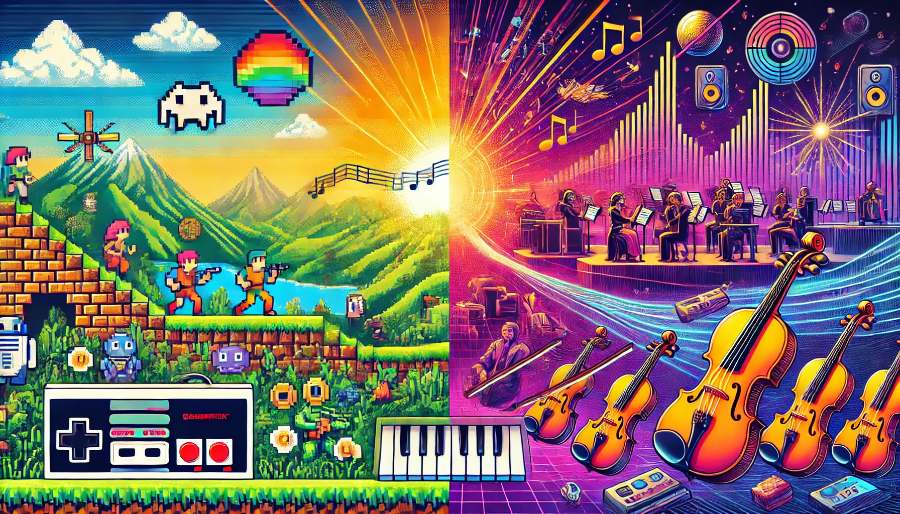Video game music has come a long way since the simple beeps and boops of early arcade games. As video games have become more immersive and cinematic over the years, their soundtracks have evolved into full-fledged works of musical artistry that enhance gameplay and evoke powerful emotions.
Early Days: Basic Chiptunes
In the early days of video games, from the 1970s through the 1980s, in-game sound was extremely limited due to the primitive sound chips in gaming hardware. Game music from this era was created using basic synthesized tones and beeps from sound chips like the ones found in the Atari 2600 and Nintendo Entertainment System.
While primitive, these early chiptunes laid the groundwork for more advanced game music. Composers worked within the limitations of the hardware to create memorable melodies, like the theme from Super Mario Bros. Early game soundtracks also used looping musical phrases during gameplay, an innovation that dynamic modern game scores are built upon.
16-Bit Era: Orchestral and Rock Expansion
The 16-bit era of gaming in the late 80s and early 90s brought improved audio capabilities to consoles like the Sega Genesis and Super Nintendo. With more channels and better-quality synths, composers could create more complex melodies and harmonies.
Many games incorporated fuller orchestral instrumentation and even live instrument recordings. Epic adventure and RPG genres lent themselves to symphonic scores, like those heard in the Final Fantasy series. Pop and rock music also infiltrated game soundtracks, especially in sports games like the early Madden NFL series.
The 16-bit era marked an artistic turning point, where game music shifted towards resembling film scores and popular music. This expanded the possibilities for interactive game scoring.
3D Polygonal Games: Dynamic and Cinematic
The shift to 3D polygonal graphics in the mid-90s further expanded interactive audio in games. Games with 3D worlds required more dynamic and ambient music that could adapt to gameplay and player choices.
Styles expanded as well, incorporating hip-hop, electronic, metal, and other contemporary genres. The increased storage space of CD-ROM also allowed for recorded vocals, spoken dialogue, and higher-fidelity instrument samples.
Games like Wipeout and Tony Hawk Pro Skater featured licensed popular music tracks that energized their gameplay. Other games used sweeping orchestral scores and choirs to heighten their cinematic flair, like Halo and Mass Effect. Dynamic 3D game music added atmosphere while integrating with on-screen action.
Modern Sound: Custom Scores, Licensed Music, and Interactive Mixing
In modern games, especially big-budget AAA titles, music is an integral part of development, involving both custom-composed scores and licensed popular music.
Games like God of War and The Last of Us have sweeping orchestral scores that evoke films while dynamically reacting to gameplay. The Grand Theft Auto series incorporates radio stations of licensed music. Even indie games feature quality composed scores, like Undertale and Journey.
Advances in interactive music middleware allow for complex mixes with layers of intensity and seamless transitions based on player actions. Game audio engines can mix different stems of music on the fly while accounting for sound effects, dialogue, and ambience.
Modern games also incorporate player music libraries for customizable soundtracks. The range of music in modern gaming allows for deeply cinematic, emotive adventures.
Key Game Music Composers and Innovators
While many composers have contributed to video game music, a few standouts have had an outsized influence on shaping game audio innovation and artistry:
- Koji Kondo: Composer for multiple Mario and Zelda titles, Kondo created some of the most iconic melodies in games. His music is catchy and melodically driven.
- Nobuo Uematsu: Lead composer for many Final Fantasy games, Uematsu brought an emotive orchestral style to RPG adventures.
- Tommy Tallarico: One of the first rock musicians in gaming, Tallarico pioneered the incorporation of mainstream music genres.
- Michael Land: Composed dynamic scores for games like Monkey Island and established interactive music techniques still used today.
- Jesper Kyd: His eclectic mix of electronic, orchestral, and ethnic influences for franchises like Hitman and Assassin’s Creed pushed game music innovation.
- Marty O’Donnell: Created the iconic Halo theme and crafted epic militaristic scores that shaped cinematic FPS music.
- Austin Wintory: Wintory’s Grammy-nominated score for Journey showed how indie games can have emotional orchestral music.
Music Defines Gaming Experiences
Today, game soundtracks encompass every music genre and style. Iconic tunes become tied to characters, franchises, and gaming memories.
While early game music was limited by technology, it laid the groundwork for game scores that can dynamically flow with player actions. Modern games use audio middleware to enable cinema-quality music.
From chiptunes to orchestras, game music has evolved into an art form that immersively enhances interactive experiences. Audio innovation will continue driving gaming’s emergent frontier. But melodies from classic games will persist in our nostalgia. The beeps of Pac-Man and the soaring themes of Mario and Zelda still define their eras.
Game music shares the long history of this creative interactive medium. The purpose of game scores is to continue innovating yet build on past innovations. Gaming’s musical tapestry, woven through time, captures the art form’s growing richness.


1 thoughts on “Evolution and Artistry of Video Game Soundtracks”